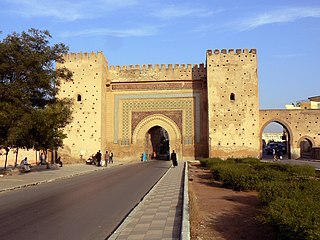
Meknes is one of the four Imperial cities of Morocco, located in northern central Morocco and the sixth largest city by population in the kingdom. Founded in the 11th century by the Almoravids as a military settlement, Meknes became the capital of Morocco during the reign of Sultan Moulay Ismaïl (1672–1727), son of the founder of the Alaouite dynasty. Moulay Ismaïl created a massive imperial palace complex and endowed the city with extensive fortifications and monumental gates. The city recorded a population of 632,079 in the 2014 Moroccan census. It is the seat of Meknès Prefecture and an important economic hub in the region of Fès-Meknès.

Fes el Bali is the oldest walled part of Fez, the second largest city of Morocco. Fes el Bali was founded as the capital of the Idrisid dynasty between 789 and 808 AD. UNESCO listed Fes el Bali, along with Fes Jdid, as a World Heritage Site in 1981 under the name Medina of Fez. The World Heritage Site includes Fes el Bali's urban fabric and walls as well as a buffer zone outside of the walls that is intended to preserve the visual integrity of the location. Fes el Bali is, along with Fes Jdid and the French-created Ville Nouvelle or “New Town”, one of the three main districts in Fez.

Fes Jdid or Fes el-Jdid is one of the three parts of Fez, the second largest city of Morocco. It was founded by the Marinids in 1276 as an extension of Fes el Bali and as a royal citadel and capital. It is occupied in large part by the historic Royal Palace, which was once the center of government in Morocco and which is still used on occasion by the King of Morocco today. The district also contains the historic Mellah of the city. Since 1981 it has been classified, along with Fes el-Bali, as a UNESCO World Heritage Site.

The Bou Inania Madrasa or Bu 'Inaniya Madrasa is a madrasa in Fes, Morocco, built in 1350–55 CE by Abu Inan Faris. It is the only madrasa in Morocco which also functioned as a congregational mosque. It is widely acknowledged as a high point of Marinid architecture and of historic Moroccan architecture generally.
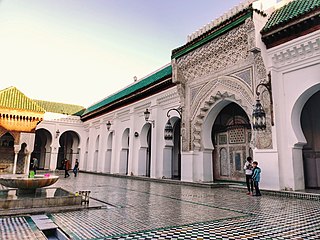
Fez or Fes is a city in northern inland Morocco and the capital of the Fès-Meknès administrative region. It is the second largest city in Morocco, with a population of 1.11 million, according to the 2014 census. Located to the northwest of the Atlas Mountains, it is surrounded by hills and the old city is centered around the Fez River flowing from west to east. Fez has been called the "Mecca of the West" and the "Athens of Africa". It is also considered the spiritual and cultural capital of Morocco.
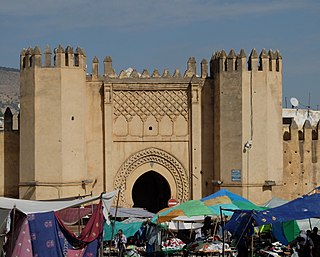
The Kasbah An-Nouar or Kasbah Filali is a walled district and former military enclosure in the old medina of Fez, Morocco. Its name means "citadel of the flowers", but it is sometimes also referred to as Kasbah Filala and Kasbah Chorfa. It is one of several fortified military enclosures or kasbahs that were built around the old city of Fez across different periods.

Dar Batḥa, or Qasr al-Batḥa, is a former royal palace in the city of Fez, Morocco. The palace was commissioned by the Alaouite Sultan Hassan I in the late 19th century and finished under his successor Abdelaziz. It was converted into a museum of historical arts and crafts in 1915 with a collection that now comprises over 6,500 objects. The palace is located near Bab Bou Jeloud at the western edge of Fes el-Bali, the old medina quarter of the city, and close to Fes el-Jdid, the new medina quarter. It is adjacent to the Dar el-Beida palace located to its southeast, which was originally part of the same complex.
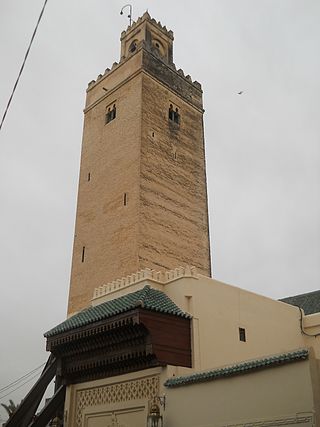
The Bab Guissa Mosque is a medieval mosque in northern Fes el-Bali, the old city of Fez, Morocco. It is located next to the city gate of the same name, and also features an adjoining madrasa.

The Royal Palace or Dar al-Makhzen is the palace of the King of Morocco in the city of Fez, Morocco. Its original foundation dates back to the foundation of Fes el-Jdid, the royal citadel of the Marinid dynasty, in 1276 CE. Most of the palace today dates from the 'Alawi era. The vast grounds are home to multiple private structures, patios, and gardens, but historically also included administrative offices and government tribunals. Today, the most publicly visible parts of the palace are its main entrances at the Old Mechouar and the highly ornate 20th-century gates at Place des Alaouites, near the Mellah.

The R'cif Mosque is a Friday mosque in Fes el-Bali, the old city (medina) of Fez, Morocco. It has one of the tallest minarets in the city and overlooks Place R'cif in the heart of the medina.
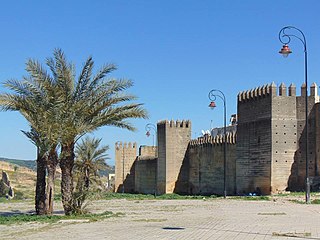
The Fortifications of Fez comprise a complex circuit of ramparts and gates surrounding Fes el-Bali and Fes el-Jdid, two urban agglomerations that compose the old "medina" of Fes, Morocco. They also include a number of kasbahs (citadels) and forts which were built both to protect and to control the city. These fortifications have been built up over many centuries and the extensive remnants today date from many different periods.

The architecture of Fez, Morocco, reflects the wider trends of Moroccan architecture dating from the city's foundation in the late 8th century and up to modern times. The old city (medina) of Fes, consisting of Fes el-Bali and Fes el-Jdid, is notable for being an exceptionally well-preserved medieval North African city and is classified as a UNESCO World Heritage Site. A large number of historic monuments from different periods still exist in it today, including mosques, madrasas, synagogues, hammams (bathhouses), souqs (markets), funduqs (caravanserais), defensive walls, city gates, historic houses, and palaces.

Tala'a Kebira is one of the longest and most important streets in Fes el-Bali, the old city (medina) of Fes, Morocco. The street runs roughly east to west, starting near the Bab Bou Jeloud and Bab Mahrouk gates in the west and ending at the al-Attarine Madrasa in the east, near the Qarawiyyin Mosque. It constitutes one of the main souq streets in the old city and a number of important historic monuments are built along it.

Place Bou Jeloud, also known as Place Pacha el-Baghdadi, is a large public square in Fes, Morocco, located west of Bab Bou Jeloud gate.

Bab Mahrouk, also spelled Bab Mahruq, is historically the main western city gate of Fes el Bali, the old walled city of Fes, Morocco. The gate dates from 1204 and is located on the northwestern corner of Place Bou Jeloud, near the edge of Kasbah an-Nouar. It was historically the approximate starting point of the old city's main street, Tala'a Kebira.

The Bou Jeloud Mosque is a historic Almohad-era mosque in the former Kasbah of Bou Jeloud, located near Bab Bou Jeloud, in Fes, Morocco.

The Oued Fes or Fez River is a river in Morocco. It is a tributary of the Sebou River and historically the main source of water for Morocco's second largest city, Fes, after which it is named.

The Mellah of Fez is the historic Jewish quarter (Mellah) of Fez, Morocco. It is located in Fes el-Jdid, the part of Fez which contains the Royal Palace, and is believed to date from the mid-15th century. While the district is no longer home to any significant Jewish population, it still contains a number of monuments and landmarks from the Jewish community's historical heritage in the city.

The Kasbah of Moulay Ismail is a vast palace complex and royal kasbah (citadel) built by the Moroccan sultan Moulay Isma'il ibn Sharif in Meknes, Morocco. It is also known, among other names, as the Imperial City or Palaceof Moulay Ismail, or the Kasbah of Meknes. It was built by Moulay Isma'il over the many decades of his reign between 1672 and 1727, when he made Meknes the capital of Morocco, and received occasional additions under later sultans.

The History of Fez begins with its foundation by Idris I and Idris II at the end of the 8th century and the beginning of the 9th century CE. It initially consisted of two autonomous and competing settlements on opposing shores of what is now known as the Oued Fes. Initially inhabited by a largely Berber (Amazigh) population, successive waves of mainly Arab immigrants from Ifriqiya (Tunisia) and al-Andalus (Spain/Portugal) over time gave the nascent city an Arab character as well. After the downfall of the Idrisid dynasty, it was contested between different Zenata groups allied with either the Fatimid Caliphate or the Umayyad Caliphate of Cordoba. In the 11th century the Almoravid sultan Yusuf ibn Tashfin conquered the region and united its two settlements into what is today the Fes el-Bali quarter. Under the rule of the Almoravids and of the Almohads after them, despite losing the status of capital to Marrakesh, the city remained the economic and political center of northern Morocco and gained a reputation for religious scholarship and mercantile activity.























